by R.K. Campbell | Contributing Editor
Specifications:
- Optional thumb safety
- Frame Size: Compact Slim
- Caliber: 9mm
- Action: Internal Hammer Fired
- Capacity: 8+1 Rounds
- Barrel Length: 3.675″
- Front Sight: White Dot
- Rear Sight: White Dot, Adjustable for Windage
- Frame Width: 1.04”
- Overall Height: 5.05”
- Overall Length: 6.85”
- Sight Radius: 5.875”
- Weight: 23.2 ounces
- Barrel Material: Stainless Steel with Armornite® Finish
- Slide Material: Stainless Steel with Armornite® Finish
- Frame Material: Polymer
Today’s shooters have greater choice than at any time in history.
Design, execution and precision manufacture with the benefits of CNC machinery are among the many advantages of modern handguns. Specialized models and handguns designed for specific duty are not only available they are affordable.
A good example is the recently introduced Smith and Wesson M&P9 EZ (EZ Rack). This handgun is offered for those with limited hand strength. It works fine for anyone wishing to own a compact 9mm semi-auto pistol. Those preferring a crisp single action trigger and manual safety have a choice that is much different than a compact 1911 type as an example.
The handgun is similar in appearance to the original Shield but the mechanics are different. The 9mm EZ builds on the success of the .380 EZ. The EZ types use a hammer fired mechanism and hidden hammer, a distinct departure from the modern polymer frame striker fired handguns. I suppose any firearm is better than no firearm but my experience and study makes the .380 ACP unacceptable for personal defense. The 9mm Luger (and .38 Special) are baselines for personal defense. The M&P9 EZ 9mm pistol offers many of the same advantages of the .380 ACP version with a tad more weight and without excessive recoil.
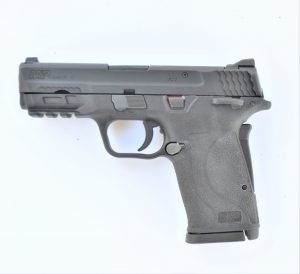
The EZ Rack 9mm is a well-designed and executed handgun.
The EZ design makes loading the magazines, racking the slide and manipulating the handgun easier. Some have physical limitations and all of us will face old age one day. There isn’t a better design for easy manipulation. The magazines feature a thumb assist to help depress the magazine spring. This is easier than forcing the cartridges over the feed lips and against the magazine spring. Racking the slide is downright easy. The recoil spring is adequate if not as strong as some pistols and the action isn’t a locked breech but a delayed blowback. Easy racking is traded for a bit more recoil. The cocking serrations are well situated and offer good adhesion. There are bosses or ‘ears’ near the rear of the cocking serrations to increase leverage. The forward cocking serrations are so minimal they are not very useful in my opinion but they are part of the 2.0 Smith and Wesson Shield Treatment.
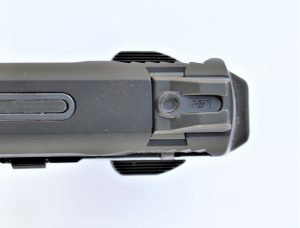
The rear sights of the M&P 9 are good choices for a personal defense handgun.
The trigger breaks clean and crisp after a modest take-up at six pounds. This isn’t a target trigger but makes a good combat trigger. The break is clean and reset rapid. Reset is fast enough but the reset click isn’t distinct to my somewhat hardened hearing. The frame treatment is well designed for both adhesion and abrasion. The slide lock and magazine release are positive in manipulation. I like the dual ambidextrous safety. This safety isn’t difficult to actuate as the pistol is brought on target. The grip safety is hinged at the bottom rather than the usual top hinged and does not lock the trigger but takes the trigger out of contact with the sear when in the safe or sprung outward position. The safety system is especially attractive. It doesn’t require much thought if any after a bit of practice and doesn’t require breaking the firing grip on the draw. I prefer a safety on a self-loading pistol and especially on a single action handgun. While the grip safety may be enough for some shooters the thumb safety isn’t difficult to disengage quickly. I am not enthused concerning the version with only the grip safety, but then for a cautious shooter it seems OK. The sights are high visibility units with a three dot white outline.
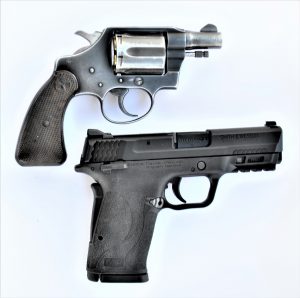
The Smith and Wesson 9mm compares favorably to the snubnose .38, upper, for concealed carry.
During my evaluation, the eight-shot magazines were easily loaded and the cocking serrations and bosses aided in racking the slide. I have used a variety of loads without a single failure to feed, chamber, fire or eject. An affordable and reliable practice loading is the Black Hills Ammunition 115 grain FMJ. I don’t have time to handload my practice loads as often as I would like and 9mm FMJ ammunition is an affordable option.
The pistol comes on target quickly. Center hits are not difficult to obtain quickly. Fast follow up shots are not difficult. Most of my practice has been at 5, 7 and 10 yards. The pistol is as useful as any compact 9mm its size. Recoil is stronger than some pistols, enough to comment on but not enough to be a problem. Overall the 9mm doesn’t kick much and the pistol remains controllable.
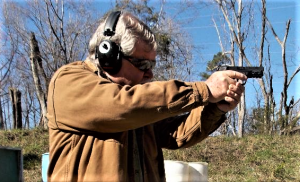
Offhand fire was pleasant and accurate.
I have fired the pistol with a number of good defense loads I trust including the Black Hills Ammunition 124 grain JHP and the Black Hills Ammunition Honey Badger. The 124 grain JHP offers an excellent balance of expansion and penetration, while the 100 grain Honey Badger is a good choice for the winter months when the threat may be heavily clothed or even behind cover.
This sharp nosed bullet relies on actual cutting damage and fluid dynamics for wound potential. It is easily the most interesting combat load of the previous decade. The pistol is controllable and offers good performance with these powerful defense loads.
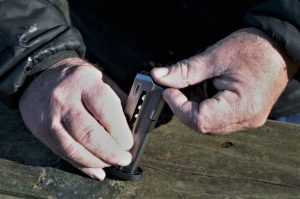
The magazines are designed for easy feeding.
I like to deploy a handgun accurate enough to behead a reptile at a few paces, take out a rodent, or hit targets at the longer end of handgun range if need be. The M&P9 EZ will make a head shot to 15 yard in practiced hands. At that range, the pistol exhibited five shot groups of 2.0 to 3.0 inches from a solid barricade rest with a variety of Black Hills Ammunition loads. In the end this pistol fits my needs and preferences more so than the Smith and Wesson Shield 9mm. It is certainly better suited to anyone that needs a bit of help racking a slide or manipulating a handgun. The M&P9 Shield EZ is a great handgun that will serve well.



